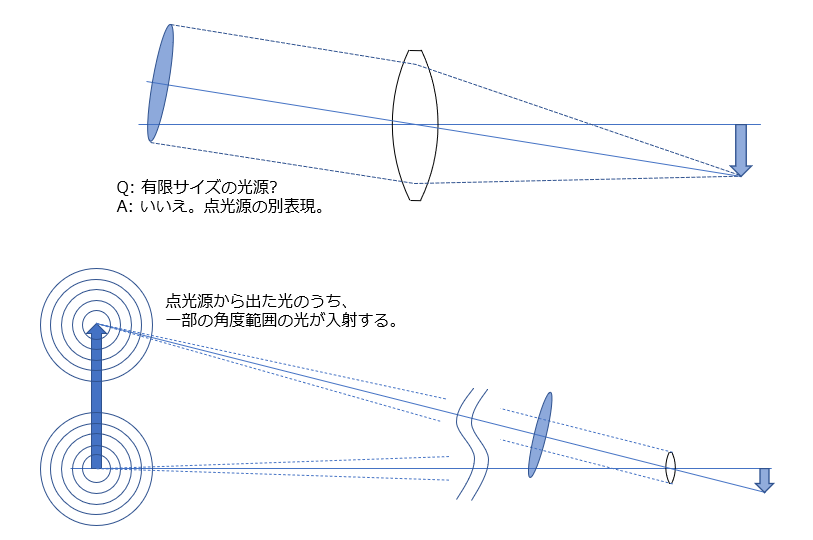Hello. Did you have any problems with optics or light?
Hikari learning aims to be a source that provides various information under the theme of “optics”. The sources of information are public information on the Internet and some knowledge and experience of the author. This page describes the “imaging optical system” that you always see and hear when you start optics.
Conclusion
- The imaging optical system aims to convert a point light source into the smallest focus.
- Collimating system is also a type of imaging system
Imaging Optics/ Imaging Optical System
Meaning of imaging optical system
OpticStudio’s sequential mode mainly deals with imaging optical system. “Imaging” means to form an image on focusing plane. In a narrow sense, it means “taking in the light emitted from the observation target and forming an image of the observation target at another position”. There is a convex lens in the middle. Rays coming out of the arrow on the left side are refracted by the lens, then reach to the arrow turned over on the right side. That figure shows exactly the imaging optics.

However, OpticStudio can handle with bigger range of imaging optics than just focusing system.
“Optical system aimed at converting a point light source into a point image”
Here, the word “point” needs a little attention. Speaking of a point (light) source, we assume a light source with a zero emission area that emits light spreads radially. The arrows in above figure can be considered as a collection of point light sources. But how can we think in case that light source is at infinity far?
You may have seen a figure that represents the light entering an optical system as if it is a cylinder with a finite diameter (top of Figure 3-2). A common misconception is that “this light has a finite emission area = it is not a point light source.” However, the light emitting area of this light source is zero, which is the same as one point on the arrow written in Fig 3-1 (lower part of Fig. 3-2). Certainly, it has a finite area when it enters the optical system, but the original emission area is zero, and the light source of the light rays drawn in Fig. 3-1 and Fig. 3-2 are essentially same.

If the rays entering the optical system can be expressed as parallel rays, the rays exiting the optical system could be expressed as parallel rays. This is an optical system called a collimator that converts divergent light into parallel light. In other words, even if the final surface of the optical system is not focusing plane, it can be regarded as an imaging optical system. This idea that collimator is also imaging system generated “angle space”. If all rays enter the image plane with same angle, the “area” of angle space is zero, which is almost same as perfect imaging.

Here are some notes about imaging optics.
(1) The imaging optical system aims to convert a point light source into the smallest focus.
(2) The tube of light reaching the optical system from infinity is also from a point light source (= emitting area is zero.)
(3) Even if the rays emitted from the optical system are parallel, it can be treated as an imaging optical system.
Examples of an optical system that is not an imaging system
In industries where optical technology is used, there are many optical systems that are not imaging systems. There is no clear division, but at least OpticStudio clearly divides it into the “illumination optical system” handled in non-sequential mode. Also “laser optical system” that handles in sequential mode.
In addition, there is a vast world that deals with optical phenomena that cannot be dealt with by geometrical optics. Perhaps, the technologies outside geometrical optics may be hotter for the optical industry.
Summary
Here, we will take up the “imaging optical system” that appears in the introduction from the public article that can be accessed from the Zemax homepage.


コメント